ASUS Pro WS C621-64L SAGE/10G Motherboard SPECworkstation 3.0.2
SPECworkstation 3 has been updated to 3.0.2 which measures the 3D graphics performance of systems running under the OpenGL and Direct X application programming interfaces. As a result of the new update, we cannot compare between past version 3 results so we will show the screenshot of the results here and graph them in later reviews.


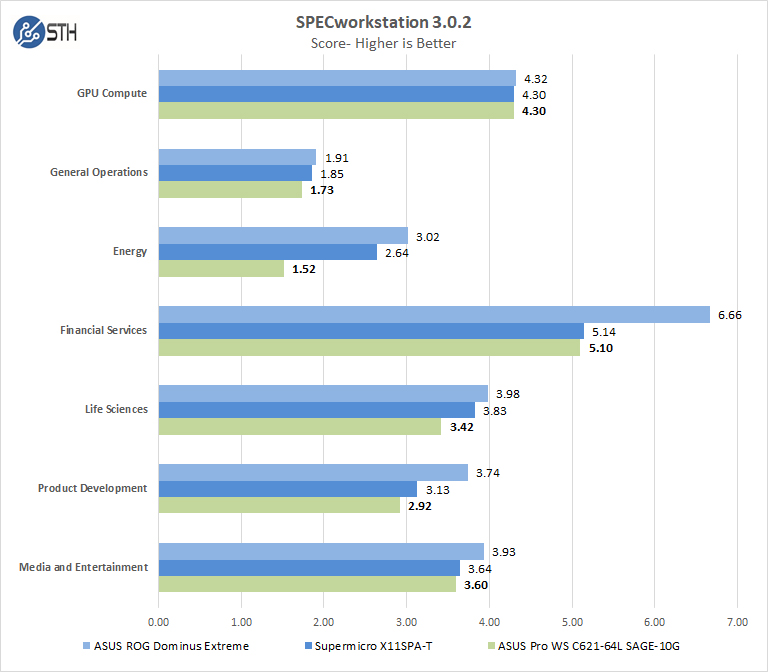
In SPECworkstation 3.0.2 the ASUS ROG Dominus Extreme dominates the results and it is hard to catch up to, while the Spuermicro X11SPA-T holds second-best results.
ASUS Pro WS C621-64L SAGE/10G Motherboard PassMark 9
PassMark Performance Test allows you to benchmark a PC using a variety of different speed tests; it tests the entire PC and all its components.

Passmark 9 was a benchmark we had issues with on the Dominus Extreme, meanwhile, the ASUS Pro WS C621-64L SAGE/10G Motherboard passes its score by over 200 points but falls short compared to the Supermicro X11SPA-T.
ASUS Pro WS C621-64L SAGE/10G Motherboard PCMark 10
PCMark 10 is another system benchmark that we have not run to date but will start doing so in future reviews.
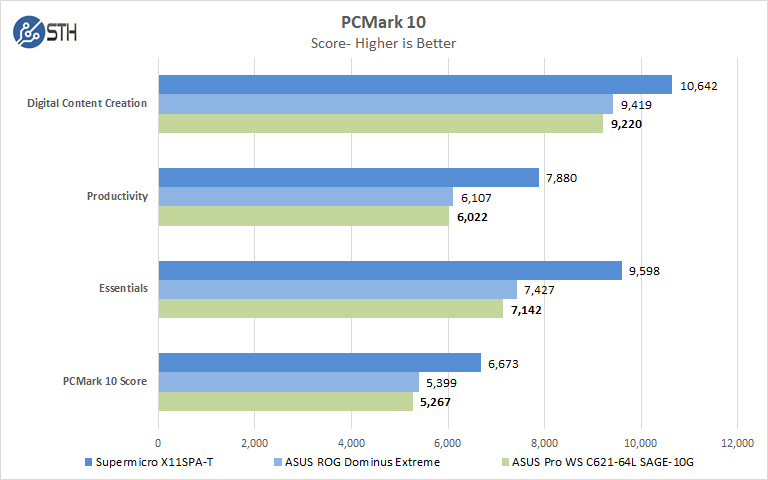
PCMark 10 was another benchmark where we saw similar performance to the ASUS ROG Dominus Extreme.
ASUS Pro WS C621-64L SAGE/10G Motherboard Blender Benchmark
The benchmark consists of two parts: a downloadable package which runs Blender and renders on several production files, and the Open Data portal on blender.org, where the results will be (optionally) uploaded.
We’ve built the Blender Benchmark platform with maximum focus on transparency and privacy. We only use free and open-source software (GNU GPL), the testing content is public domain (CC0), and the test results are being shared anonymized as public domain data – free for anyone to download and to process further. This benchmark can be downloaded here.
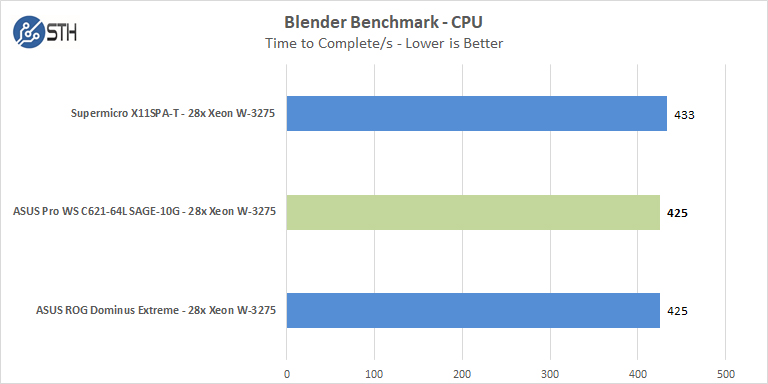
Here the results are tightly grouped so we would say the three solutions perform relatively similarly.
Next, we are going to look at AIDA64 CPU Benchmarks.

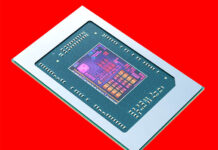
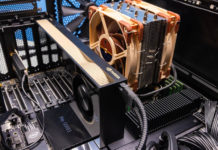

Don’t buy this board, why? Because of the ASMB9-iKVM.
I currently have a Asus X299 PRO/SE motherboard with the same ASMB9-iKVM and it’s practically useless. All sensors show critical, always, even all sorts of voltages (system is fine). The GUI also sucks.
Taking over the console does not work when using a separate GPU instead of the onboard which makes it pretty much useless.
Also had many problems at the beginning when the system woulden’t pass POST without a couple of resets but this was fixed in a later BIOS.
No more Asus ‘Pro’ motherboards for me.
Only one M.2.
Its hard to find out how does this board stands out – everything is typical.
their ipmi(x99,x299) is indeed terrible, I had problems saving ip configuration(“unknown error” on save), working with smash-clp that had none of the gui pages(no sensors, no logs) and it did not work with ipmitool (over kcs) well – changes failed save. couple of times the ipmi interface stopped responding to its ip address and need to be power cycled.
What about Thunderbolt 3? That’s very important for a lot of the workstation market. Looks like you’ll need to lose the x4 PCIe slot for that, so you’re left with only 4 slots. I’m typing this from a Supermicro X10DRG-Q based workstation that is almost five years old. It has six PCIe cards installed, and I still have one more remaining if I need it (which I might soon). I couldn’t do that on this Asus board. Also, a new Asus Xeon W-3200 system is only about 30% faster by these benchmarks. I know this is single-socket, but to me it just underscores how underwhelming the progress has been on Intel workstation platforms. I definitely would’ve upgraded if there had been something interesting.
I would really like to see some Epyc 7002-based *workstation* solutions (not server). That would be exciting.
We use ASMB9 and it’s just the SP-X rebranded. I think the special part about this motherboard is 64 PCIe lanes from the CPU with more from the PCH for NVMe drives.
@Tyler:”I would really like to see some Epyc 7002-based *workstation* solutions (not server). That would be exciting.”
And you couldn’t be bothered to do a Google search for “Epyc workstation mainboard”? There are enough options, albeit for the 7001 platform. However, they are supposed to be compatible with 7002. And you are essentially only missing on PCIe 4 which Intel don’t have anyway.
Also, why would you think a server mainboard is not suitable for a workstation?
@Nikolay Mihaylov: “Also, why would you think a server mainboard is not suitable for a workstation?”
Because of orientation of RAM slots. For workstation I prefer vertical orientation while for server obviously horizontal. There is no single Epyc board which would support 700*2* and yet provide vertical RAM slots orientation. Or have you found any?
@Tyler: “I would really like to see some Epyc 7002-based *workstation* solutions (not server). That would be exciting.”
Me too, but, it looks like AMD is preparing something for Threadripper. Rumored 3 chipsets make me curious if WRX80 will really be for workstation. Rumored capability of supporting (L)RDIMMS (besidees UDIMM ECC) and in 8-channel manner allows some hope here. So let’s see in the future…
@KarelG: “Because of orientation of RAM slots.”
I’m sorry but this is the most ridiculous excuse I’ve ever heard.
This motherboard is awesome, but Intel did go wrong with cpu lineup/segmentation with constant adjustements. Best is a xeon W3200 but when looking at xeon W2200 the cpu is no more interesting…